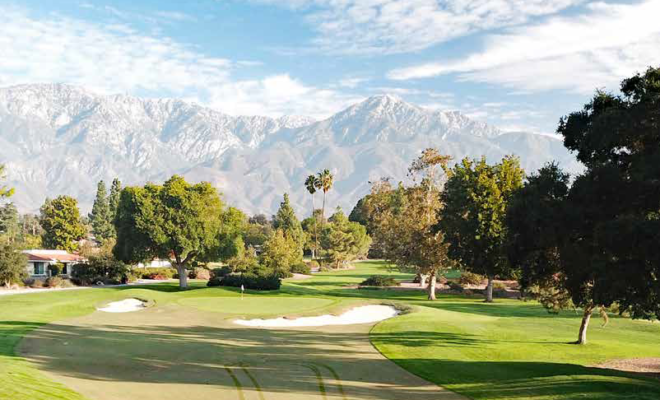A Return to SoCal: The U.S. Open at LACC is the Start of Something Big

Even for those who closely follow the machinations of professional golf’s major championships, the announcement came as quite the surprise.
The Los Angeles Country Club was already scheduled to host its first U.S. Open in 2023, and it figured that both the club and the United States Golf Association would consider that a good test run for possible future championships held there.
Would the North Course be a stern enough examination for the modern player? Could the small footprint of the site handle even the relatively small number of fans who would be in attendance? Would the LACC membership warmly embrace the U.S. Open as they did the Walker Cup when it was played at the club in 2017?
Those are all reasonable questions, but in a move that speaks to the mutual confidence that the parties have in how the 2023 U.S. Open will go, the USGA announced in mid-October 2022 that LACC would be the site of the 2032 U.S. Women’s Open and the 2039 U.S. Open.
PULLING BACK THE CURTAIN
Yes, they are planning that far ahead, with six fabled golf courses scheduled as far into the future as 2051 to host the U.S. Open. And like Pebble Beach, Merion, Oakmont and Shinnecock Hills, the George C. Thomas layout at LACC will have the full attention of the USGA long before the first ball is struck in the national championship scheduled for June 15-18.
This U.S. Open will be the first held in the Los Angeles area since 1948, when Ben Hogan triumphed at The Riviera CC eight months before his near-fatal car accident.
“There’s always a bit of mystery and allure and certainly excitement because it’s the first,” said John Bodenhamer, the USGA’s chief championships officer. “Growing up in the Northwest, I had always heard about the USGA’s desire to have a U.S. Open at LACC, and I think there’s one reason for that — the architecture. With the barranca running through it, it’s a wonderful piece of property, and George C. Thomas was a genius at incorporating that into the design. Because of that, it’s a place the USGA has wanted to go to for many years.”
The long-term commitment to LACC signals a change of heart and mindset for both the USGA and the club.
In the early 2000s, the USGA worked to incorporate public courses such as Torrey Pines, Bethpage Black and Chambers Bay into the U.S. Open rotation, and all were sites that afforded the governing body sizeable crowds and big revenues to match. But there’s been a move lately to return to smaller venues such as Merion and The Country Club in Brookline, which boast more historical cachet, even if the profits might be less.
For LACC’s part, it decided to issue an invitation to welcome a golf tournament whose scale is arguably the largest in professional golf, even if the USGA was looking at no more than about 22,000 fans on the property each day.
After hosting five Los Angeles Opens, beginning in 1926, along with two USGA championships, LACC held outside tournament golf at arm’s length for decades, starting in the late 1950s. A former club president, Charles Older, tried to rally support for hosting the 1986 U.S. Open, but the board voted 5-4 against it. LACC hosted the 1954 U.S. Junior Amateur, won by Foster Bradley Jr. over Al Geiberger, but the club then cancelled plans to stage the 1958 U.S. Amateur, which was moved to The Olympic Club in San Francisco.
But as the leadership of LACC evolved, so did the attitude about pulling back the curtain and showing off the place. The membership’s enthusiasm was buoyed by architect Gil Hanse’s loving and painstaking renovation of the Thomas design on the North Course, which was completed in 2010. LACC already had invited the USGA to hold the 2017 Walker Cup there, and as the relationship blossomed, so did the talks of something bigger.
A COMMITMENT TO SOCAL GOLF
Richard Shortz, a longtime LACC member and former club president who is now serving as co-chair for the U.S. Open, remembers hosting then USGA president Tom O’Toole for a round in 2013, during which they began discussions about holding the national championship. Eighteen months later, the membership put it to vote.
“It was 90 percent in favor of doing it,” Shortz said. “There is a lot of enthusiasm about working with the USGA. The club has become a lot more community oriented. As we look around at the landscape of golf and see what we might do in the community, that played a role in our thinking.”
LACC and the USGA’s commitment to Southland golf is significant. Working with the SCGA Junior Golf Foundation, the 2023 U.S. Open Community Legacy campaign will be a significant part of the championship and will have a lasting impact on the opportunities for underserved youth in SoCal. This will be a first-of-its-kind project financially supported by the SCGA, USGA, LACC and its members. In addition, the USGA, with the support of LACC, will extend the USGA Pathways Internship Program to 20 young adults for the U.S. Open this summer.
Anticipation for the U.S. Open at LACC is high, considering how differently this championship could look and play compared to the 122 that have come before it. First, there is the wholly unique aspect of a rugged, naturalistic golf course sitting smack in the middle of one of the most populated urban areas on Earth. “It’s like if they had a golf course in New York’s Central Park” is how U.S. captain Spider Miller described LACC before the Walker Cup.
Then there’s the nature of the North Course itself. For those who watched in person or on television as the U.S. squad that included Scottie Scheffler, Collin Morikawa, Will Zalatoris and Cameron Champ dominated Great Britain & Northern Ireland in September 2017, the ruggedness of LACC might have come as a shock. After Hanse’s renovation, the way in which the barranca winds through some of the holes, many of which are accentuated by fescue-lined bunkers, is more Shinnecock Hills or Bethpage Black than Augusta National.
The North Course can play as long as 7,550 yards for the Open, but it’s not the length that will be the standout challenge. The fairways and rough are composed of Bermuda grass, and the USGA’s plan is to keep the fairways wide enough to bring Thomas’s movement and flow into play while punishing those who don’t use thoughtful strategy. Tellingly, there will be no first cut of rough; balls could go from a fairway lie to three inches or more of thick stuff with nothing in between to mitigate the mistake.
And maybe more than at most major venues, the par-3 holes will have a huge say in who wins the championship. That’s because there are five on the course, and in a tantalizing scenario, there could be a round in which the signature 11th plays at nearly 300 yards while the 15th is a half-wedge at 78 yards. That’s truly a wonder in golf’s bomb-and-gouge era.
Relishing the opportunity at 15, Bodenhamer said, “Every golfer in America can relate to it because they can play it. Not everybody can hit it 300 yards.”
“Firmness” is the USGA’s buzzword for this Open, for both the fairways and greens. Unlike so many Midwest and Eastern U.S. Opens in which the course conditions are ultimately decided by the week’s weather, Bodenhamer is thrilled to know that he’s virtually guaranteed a fast track in which he can dial in the conditions he wants.
“Talk to all of the great players,” said Bodenhamer, “and they’ll tell you that having firm and fast conditions is when the cream rises to the top.”
Is there a potential for the pros to scorch LACC with some low scores? Maybe. There is some precedent, with current PGA Tour pro Max Homa having fired a 61 on the North Course on his way to victory in the 2013 Pac-12 Championships. But the USGA expects to provide drama without trickery.
“We’re not going to force a score,” Bondenhamer said. “It will be whatever the architect intended. Firmness, a variety of angles and the rough will be our friend.”
Know this: With their long-term commitment to L.A., both the USGA and LACC are going to make every effort to ensure that this first major bow is a blockbuster.















